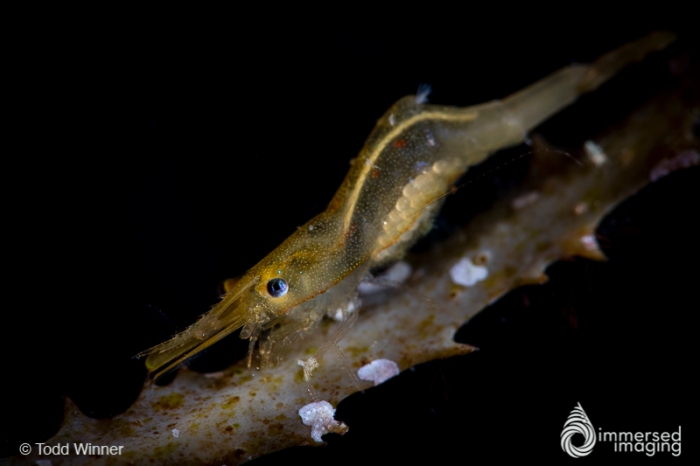
Shrimp on wire coral. Canon 5DS-R, EF 100mm Macro, 1/200, f/13, ISO 320

Whip coral Gobies. Canon 5DS-R, EF 100mm Macro, 1/200, f/11, ISO 160
Key settings
- Macro lens
- Manual camera exposure.
- Fast shutter speed that will sync with your strobes (1/125 -1/250)
- Small aperture (f/11 – f/18)
- Low ISO (100-200)
- Manual or TTL strobes ( If shooting TTL your subject needs to fill a large portion of the frame)
- Subject or camera angle that allows for open water behind the subject.

Shrimp with eggs on kelp. Canon 5DS-R, EF 100mm Macro, 1/200, f/14, ISO 160
Getting the Shot
- After finding a subject with a few feet of water behind it, set your camera to manual and adjust shutter speed, aperture and ISO.
- Take a shot with your strobes turned off. You should be seeing a black frame. If not, double check your settings, use a smaller aperture and or point your camera away from the sun.
- Turn on your strobes and take a shot. Fine tune your exposure by adjusting strobe power and or distance if using manual strobes or use flash compensation if you are shooting TTL strobes. If there is a lot of particles in the water you may get some backscatter. To reduce backscatter, you can try tilting the strobes out slightly to just get the edge of the light or try reducing the strobe power and either moving in closer or opening up the aperture a bit. If done correctly you should be seeing a saturated foreground subject with a nice black background.

Donut nudibranch. Canon 5DS-R, EF 100mm Macro,1/200,f/13, ISO 160





